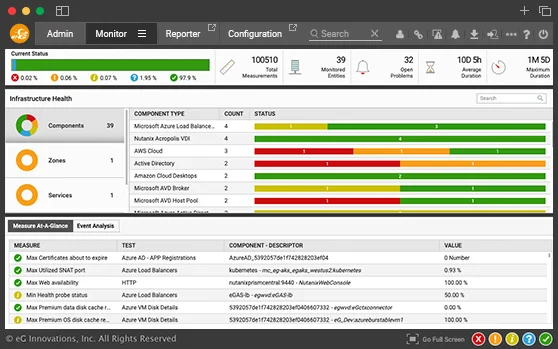Network Configuration Change Tracking
Eliminate Guesswork with Unified Configuration Visibility
Free TrialWhy Monitor Configuration and Change?
There are many instances of performance issues with business-critical services being caused because a server, network device, or application was not correctly configured. Human errors during updates to the configuration may also cause unexpected performance degradation. Thus, the need for server, application and network configuration change tracking.
- Misconfigurations have a huge negative impact on performance
- Configuration errors are the major cause of incidents resulting in downtime and outages
- Configuration change management is a mandatory requirement for regulatory compliance
We have no more frustrations because now we know where the problem is, and the root cause of issues is detected in minutes. With the eG Enterprise performance monitoring suite we deliver a robust and reliable environment that guarantees maximum uptime and user satisfaction.![]()
Knowing what configuration changes have happened around the time when a significant performance change was observed allows administrators to more accurately and rapidly identify the cause of a problem and to bring the IT services back to normal operation quickly. By eliminating guesswork, unified configuration and performance monitoring allows IT organizations to enable server, application and network configuration change tracking. This helps reduce mean time to repair, improves service uptime and reduces IT operations costs.
Change and Configuration Monitoring using
eG Enterprise
eG Enterprise provides administrators with the ability to view configuration and change management from a central web console. It employs agent-based and agentless mechanisms to extract critical configuration and change details from each of the managed components in the environment.
In addition to OS and network configuration change tracking, the eG Configuration Manager also obtains configuration information at the application layers.
Capabilities of the eG Configuration Manager
- Track server assets
- Monitor the current configuration of network devices, servers, and applications
- Compare current configuration across servers
- Report on configuration changes during specific time periods
- Compare configuration across servers; Identify servers that are deviating from a golden configuration
- Search for networks, servers, applications with a specific configuration
By tracking the configurations of a component over time, eG Enterprise also reports on configuration changes and when the changes happened. By time correlating change information with performance information, administrators can get vital clues as to whether any configuration changes (whether automated, manual, or unintentional) may have caused a performance degradation.
Administrators can also use Change and Configuration Tracking to compare configurations across applications, servers, and networks. This way, if one server is performing well, but another is not, an administrator can quickly determine configuration differences between the two servers that could be responsible for the performance difference.
What the eG Enterprise Change and Configuration Tracking Reveals
- Which platforms is a particular application currently running on?
- Is an unlicensed copy of an application being used anywhere?
- What are all of the applications currently executing on a particular system?
- Which versions of an operating system are currently available in the target infrastructure?
- Do any operating systems need to be upgraded?
- What is the current configuration of an application?
- Is all mandatory software (such as antivirus software) available and running on all managed systems? If not, which systems do not have such software?
- Are all services critical to the functioning of the system and applica tions up and running?
- Has a particular software patch been applied to all target systems?
- Do any systems require additional hard disk space? If so, which ones?
- Do any systems require more RAM? If so, which ones?
- Have all Windows systems been updated with their latest service pack?
- Have any configuration changes occurred during a stipulated period? If so, when and what are the details?
- Could a particular configuration change have induced a drop in the performance of the system or application?
- Can any difference be noticed in the configuration of two components of the same type? If so, could this difference be the cause for the poor performance of one of the components?
The eG Enterprise configuration and change monitoring functionality is supported for Windows, Solaris, Linux, HPUX, AIX, OpenVMS and AS/400 operating systems, VMware vSphere and Citrix XenServer virtualization platforms, and applications including Citrix XenApp, Microsoft Terminal servers, Oracle database servers, Microsoft SQL, Microsoft IIS, and Apache web servers.
Benefits of the eG Enterprise Change and Configuration Tracking
- Assess how a configuration change could have influenced overall performance of the system, application or service;
- Compare configuration across infrastructure components and identify components that may not be configured correctly;
- Detect unplanned/unauthorized configuration changes in the click of a button;
- Generate a snapshot of all IT assets of an organization including applications, operating systems, devices, software, hardware, and services;
- Quickly access the basic configuration information pertaining to any network device, server, application, or virtualization platform in the infrastructure;
















